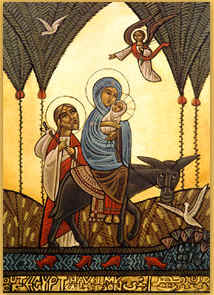|
Christian Art in Egypt

The history of Christian Art in Egypt may be divided into two periods
presenting entirely different characteristics. The first extends from the
beginning of the fourth century to the Arab conquest (640-642), the second from
that date to the present time. During the first period, Egypt was a province of
the Byzantine Empire in the domain of art. Its art exhibits the close relations
between the Nile Valley, the capital, and other provinces especially Syria. At
that time Alexandria was one of the most important cities of the world as it had
a remarkable position in the history of commerce, beside its eminence in the
history of civilizations. Thus the artistic influences of Asia found easy access
to spread throughout Egypt.
Christian art in Egypt was profoundly and almost essentially a decorative
art. Walls, columns, and capitals were covered with paintings and frescos. Like
the Alexandrian art, the Coptic art is extremely fond of realism, the so-called
Faiyum portraits and which we find again in frescoes of Saqqara and Barvit. The
Hellenistic style shows itself persistently in the decoration. Plinths have
paintings in imitation of marble encrustation and friezes with circles and
lozenges framing flowers, fruit baskets, birds and even portraits or symbolical
figures and genre-figures.
During the second period of Christian art, Christian decoration art became in
a state of complete decadence due to several political and social changes. Stone
sculpture disappeared almost entirely after the 8th century; few slabs crudely
droned with interlacing patterns and capitals of a very simple type are found.
By the 11th Century, work in stone was completely abandoned.

Of the painting of the period we can find some examples at Deir Suryani and
Deir Abu Maqar and at the Monastery of St. Simeon near Aswan, but all these
frescoes show strong foreign influences mainly Armenian.
Decorative effort focused on the carving and inlay of wood. The ikonostasis
of the Church of Abu Sargah of the 11th century with others formerly in the
Church of El-Muallaqa, now in the British Museum, are the best examples of their
kind. By the 14th century Coptic art may be said to be extinct, neither its
buildings nor its decorations show sufficient character to distinguish them from
the productions of Islamic art.
Back to History page |